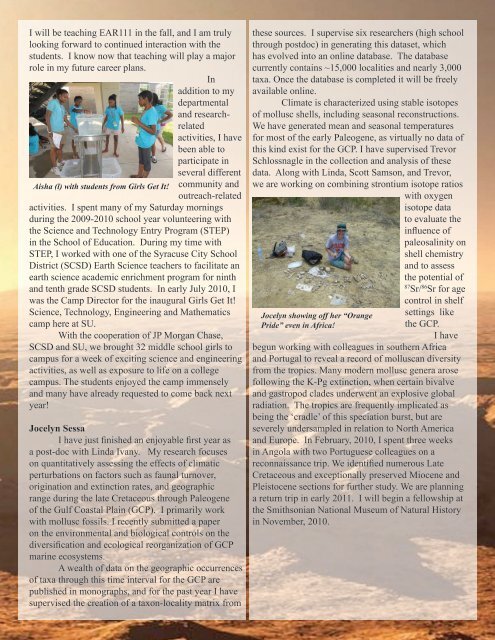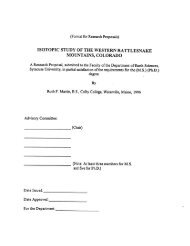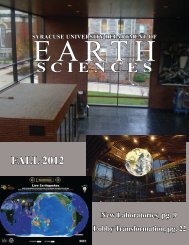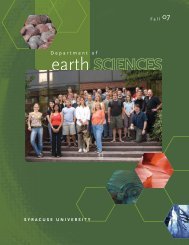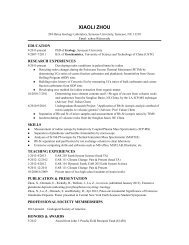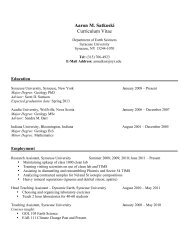alumni reception - Syracuse Universe Department of Earth Sciences ...
alumni reception - Syracuse Universe Department of Earth Sciences ...
alumni reception - Syracuse Universe Department of Earth Sciences ...
You also want an ePaper? Increase the reach of your titles
YUMPU automatically turns print PDFs into web optimized ePapers that Google loves.
I will be teaching EAR111 in the fall, and I am truly<br />
looking forward to continued interaction with the<br />
students. I know now that teaching will play a major<br />
role in my future career plans.<br />
In<br />
addition to my<br />
departmental<br />
and researchrelated<br />
activities, I have<br />
been able to<br />
participate in<br />
several different<br />
Aisha (l) with students from Girls Get It!<br />
community and<br />
outreach-related<br />
activities. I spent many <strong>of</strong> my Saturday mornings<br />
during the 2009-2010 school year volunteering with<br />
the Science and Technology Entry Program (STEP)<br />
in the School <strong>of</strong> Education. During my time with<br />
STEP, I worked with one <strong>of</strong> the <strong>Syracuse</strong> City School<br />
District (SCSD) <strong>Earth</strong> Science teachers to facilitate an<br />
earth science academic enrichment program for ninth<br />
and tenth grade SCSD students. In early July 2010, I<br />
was the Camp Director for the inaugural Girls Get It!<br />
Science, Technology, Engineering and Mathematics<br />
camp here at SU.<br />
With the cooperation <strong>of</strong> JP Morgan Chase,<br />
SCSD and SU, we brought 32 middle school girls to<br />
campus for a week <strong>of</strong> exciting science and engineering<br />
activities, as well as exposure to life on a college<br />
campus. The students enjoyed the camp immensely<br />
and many have already requested to come back next<br />
year!<br />
Jocelyn Sessa<br />
I have just finished an enjoyable first year as<br />
a post-doc with Linda Ivany. My research focuses<br />
on quantitatively assessing the effects <strong>of</strong> climatic<br />
perturbations on factors such as faunal turnover,<br />
origination and extinction rates, and geographic<br />
range during the late Cretaceous through Paleogene<br />
<strong>of</strong> the Gulf Coastal Plain (GCP). I primarily work<br />
with mollusc fossils. I recently submitted a paper<br />
on the environmental and biological controls on the<br />
diversification and ecological reorganization <strong>of</strong> GCP<br />
marine ecosystems.<br />
A wealth <strong>of</strong> data on the geographic occurrences<br />
<strong>of</strong> taxa through this time interval for the GCP are<br />
published in monographs, and for the past year I have<br />
supervised the creation <strong>of</strong> a taxon-locality matrix from<br />
these sources. I supervise six researchers (high school<br />
through postdoc) in generating this dataset, which<br />
has evolved into an online database. The database<br />
currently contains ~15,000 localities and nearly 3,000<br />
taxa. Once the database is completed it will be freely<br />
available online.<br />
Climate is characterized using stable isotopes<br />
<strong>of</strong> mollusc shells, including seasonal reconstructions.<br />
We have generated mean and seasonal temperatures<br />
for most <strong>of</strong> the early Paleogene, as virtually no data <strong>of</strong><br />
this kind exist for the GCP. I have supervised Trevor<br />
Schlossnagle in the collection and analysis <strong>of</strong> these<br />
data. Along with Linda, Scott Samson, and Trevor,<br />
we are working on combining strontium isotope ratios<br />
with oxygen<br />
isotope data<br />
to evaluate the<br />
influence <strong>of</strong><br />
paleosalinity on<br />
shell chemistry<br />
and to assess<br />
the potential <strong>of</strong><br />
87<br />
Sr/ 86 Sr for age<br />
control in shelf<br />
Jocelyn showing <strong>of</strong>f her “Orange<br />
Pride” even in Africa!<br />
settings like<br />
the GCP.<br />
I have<br />
begun working with colleagues in southern Africa<br />
and Portugal to reveal a record <strong>of</strong> molluscan diversity<br />
from the tropics. Many modern mollusc genera arose<br />
following the K-Pg extinction, when certain bivalve<br />
and gastropod clades underwent an explosive global<br />
radiation. The tropics are frequently implicated as<br />
being the ‘cradle’ <strong>of</strong> this speciation burst, but are<br />
severely undersampled in relation to North America<br />
and Europe. In February, 2010, I spent three weeks<br />
in Angola with two Portuguese colleagues on a<br />
reconnaissance trip. We identified numerous Late<br />
Cretaceous and exceptionally preserved Miocene and<br />
Pleistocene sections for further study. We are planning<br />
a return trip in early 2011. I will begin a fellowship at<br />
the Smithsonian National Museum <strong>of</strong> Natural History<br />
in November, 2010.


